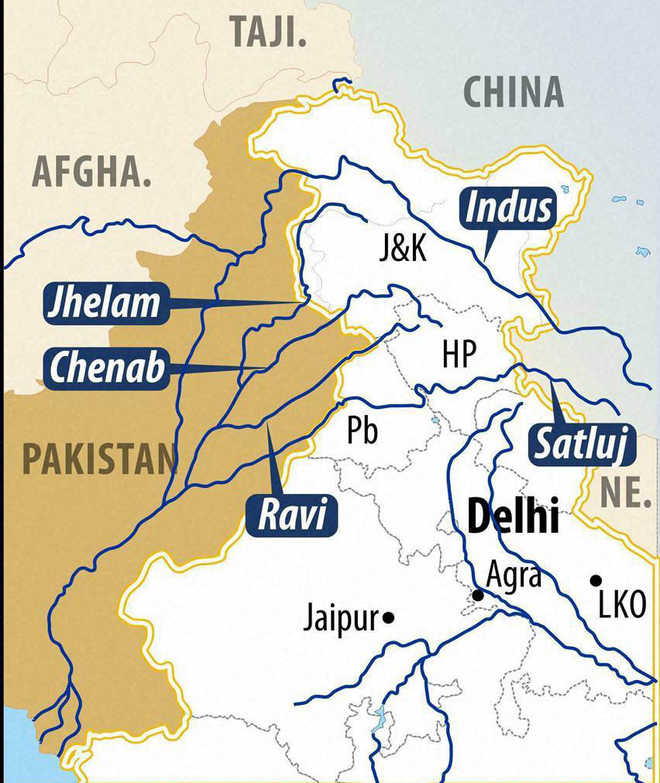INDUS WATER TREATY
Background
- It is a Water-Distribution Treaty, signed in Karachi in 1960, between India and Pakistan, brokered by the World Bank
- At the time of independence, the boundary line between the two newly created independent countries i.e. Pakistan and India was drawn right across the Indus Basin, leaving Pakistan as the lower riparian.
- Moreover, two important irrigation head works, one at Madhopur on the Ravi River and the other at Ferozepur on the Sutlej River, on which the irrigation canal supplies in Punjab (Pakistan) had been completely dependent, were left in the Indian Territory.
- A dispute thus arose between the two countries regarding the utilisation of irrigation water from existing facilities.
- Negotiations held under the good offices of the International Bank for Reconstruction and Development (World Bank), culminated in the signing of the Indus Waters Treaty in 1960.
- Since India and Pakistan depended on water from the Indus river basin for irrigation, equitable distribution and infrastructure were needed.
- In 1951, the World Bank offered to mediate the water-sharing dispute.
- Finally in 1960, an agreement was reached between the two countries, leading to the signing of the IWT.
- The Treaty was signed at Karachi by Field Marshal Mohammad Ayub Khan, the then President of Pakistan, Shri Jawaharlal Nehru, the then Indian Prime Minister and Mr W.A.B. of the World Bank on 19th September 1960.
- The Treaty however is effective from April 1960 (Effective Date).
2. About the Indus River Water treaty
- The Indus system of rivers comprises the main stem of the Indus river along with its five left-bank tributaries, namely, the Ravi, the Beas, the Sutlej, the Jhelum and the Chenab and a right-bank tributary, namely, the Kabul which does not flow through India.
- The Ravi, the Beas and the Sutlej are together called Eastern Rivers while the Chenab, the Jhelum and the Indus main are called Western Rivers.
- The Indus Waters Treaty was signed between India and Pakistan on 19 September 1960 in Karachi.
- The Treaty provides India with absolute control of all the waters of the Eastern Rivers while Pakistan shall receive for unrestricted use all those waters of the Western Rivers which India is under obligation to let flow beyond the permitted uses.
- India is permitted to use the waters of Western rivers for a. Domestic use b. Non-consumptive use c. Agricultural Use d. Generation of hydroelectric power.
- India is also permitted to construct storage of water on Western Rivers up to 3.6 million acre-feet (MAF) for various purposes as specified in the Treaty.
- Both India and Pakistan undertook to establish a permanent post of Commissioner for Indus Waters.
- The two Commissioners constitute the Permanent Indus Commission (PIC).
- Unless either Government should decide to take up any particular issue directly with the other Government, each Commissioner will be the representative of his Government for all matters arising out of this Treaty

ImageSource- Tribune
3. Functions of the Indus Water Commission
Functions of The purpose and functions of the Commission inter alia are to:
- Establish and promote cooperative arrangements for the Treaty implementation; furnishing or exchange of information or data provided for in the Treaty;
- Promote cooperation between the Parties in the development of the waters of the Indus system;
- Examine and resolve by agreement any question that may arise between the Parties concerning the interpretation or implementation of the Treaty.
4. Recent Developments
- To utilize the waters of the Eastern rivers which have been allocated to India for exclusive use, India has constructed the following dams:
- Bhakra Dam on Satluj,
- Pong and Pandoh Dam on Beas and
- Thein (Ranjit Sagar) on Ravi.
- Other works like Beas-Sutlej Link, Madhopur-Beas Link, Indira Gandhi Nahar Project etc have helped India utilize nearly the entire share (95 %) of waters of Eastern rivers.
- However, about 2 Million Acre Feet (MAF) of water annually from Ravi is reported to be still flowing unutilized to Pakistan below Madhopur.
- One of the longest conflicts that arose from Pakistan’s objections to Indian projects was over the Kishanganga Hydroelectric Project (KHEP). Kishanganga is a tributary of the Jhelum river.
5. Geopolitical Challenges
- In recent years, the Indus Water Treaty has been brought up a couple of times during geopolitical tensions between India and Pakistan. In the aftermath of the attack on J&K’s Uri army camp in 2016, Prime Minister Narendra Modi said, “Blood and water cannot flow
- simultaneously,” soon after which, the Permanent Indus Commission talks were
- suspended for that year by the Indian side,
6. Challenges in the reconstruction of the Indus Water treaty
- Expect international condemnation.
- Turning the tap off could mean flooding our cities.
- It can make neighbours like Bangladesh, the countries with which India has water-sharing arrangements, uneasy.




